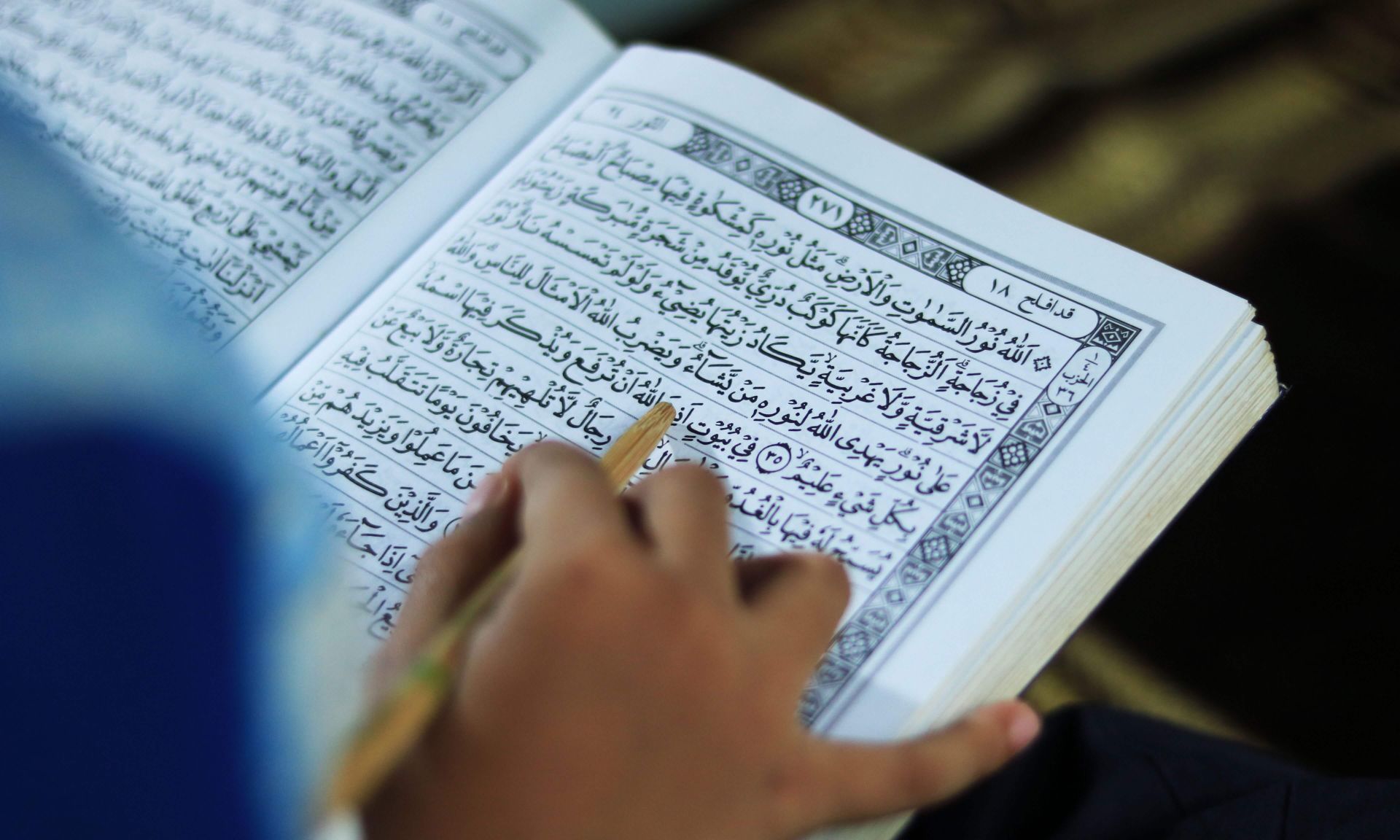What is Tajweed Quran? Meaning and Rules
-
Lily Syahirah Ramlan
-
05 June 2025
Understanding what Tajweed Quran is imperative for anyone who wants to begin learning to read the Quran with ease.
However, what is Tajweed Quran, and why is it crucial in reciting the Quran? Simply put, Tajweed is a delicate balance between both art and science of correct Qur’anic recitation.
It ensures that every letter of the Qur’an is pronounced as it was revealed to the Prophet Muhammad ﷺ; clear, accurate, and beautiful.
In this article, we’ll explore the tajweed meaning, its importance, basic and advanced tajweed rules, common mistakes when reciting the Quran with tajwid, and how to improve your recitation.

What Does the Tajweed Quran Mean?
Tajweed is derived from the Arabic root ج-و-د, which means “to make better” or “to improve.”
In the context of the Qur’an, Tajweed refers to the rules that govern how the words of the Qur’an should be recited, including articulation, pronunciation, rhythm, and pauses.
So, when we talk about the Tajweed Quran, we’re referring to a Qur’an that is recited (or printed with markers) according to these pronunciation rules.
These rules have existed for a long time during the times of Sahabah, and they preserve the authenticity of the Qur’an and ensure that its meanings are conveyed without distortion.

Why is it Important to Learn Tajweed?
1. Fulfilling the Purpose
Reciting the Quran with tajweed is literally one of the revelations mentioned in the Quran. Allah Almighty says in the Qur’an:
أَوْ زِدْ عَلَيْهِ وَرَتِّلِ ٱلْقُرْءَانَ تَرْتِيلًا
“And recite the Qur’an with measured recitation.”(Surah Al-Muzzammil, 73:4)
The word ‘tarteel’ used in this verse implies a slow, rhythmic, and deliberate recitation. Tajweed enables us to fulfill this divine command, as mentioned by Allah Almighty.
2. Error-Free Recitation
Readers should be aware of the incorrect pronunciation that can change the meaning of words entirely.
For example, mispronouncing a single letter may turn a blessing into a curse. Tajweed ensures accuracy, preventing errors in your recitation.
One of the common examples of similar words pronounced differently are ‘kalb’ (dog) and ‘qalb’ (heart).
3. Emphasis on the Understanding
Even if you don’t learn and understand Arabic as a language learner or native speaker, learning Tajweed helps develop a deeper awareness of the language.
It gives you awareness on the nuances, recognize repeated phrases, and slowly start connecting sounds to meanings.
4. Preserve the Language
One of the essential aspects of Tajweed is that it protects the classical Arabic of the Qur’an.
With the help of Tajweed, it maintains the integrity of pronunciation of every word, ensuring the language is preserved as it was at the time of revelation.
5. It Makes Recitation Beautiful and Pleasant
Who says learning Tajweed is difficult, rigid and boring? The beauty of Qur’anic recitation lies not just in the mastery of Tajweed, but how it shapes the voice and melody used by the reciter.
Proper rules create a rhythmic flow that soothes the soul and enhances focus and clarity when reciting the Quran.
6. Improve Your Memorization
When you master tajweed, it helps support better memorization. When you follow structured pronunciation, melody and rhythm, it becomes easier to recall verses accurately.
Many Huffaz (those who memorize the Qur’an) credit Tajweed as a core part of their success.
7. Respect the Qur’an
The Qur’an is a Divine revelation from Allah Almighty.
It is imperative for readers to honour the source with reverence, and one of the ways to respect it is by reciting the verses of the Quran with proper Tajweed.

What are the Basic Quran Tajweed Rules?
Before diving into advanced topics, every student must first grasp the basic Tajweed rules. Here’s what that includes:
1. Pronunciation of Arabic Letters
Each Arabic letter has a specific sound. Mixing them up can change meanings. Tajweed ensures that every letter is pronounced distinctly, especially those not found in other languages.
If you would like to learn the absolute basics of the Arabic language, beginning with the Arabic letters or Huruf Hija’iyyah, you may begin your journey with our online Arabic course for beginners here.
2. Characteristics of Letters (Sifat)
Every letter has attributes such as heaviness (tafkheem), softness (tarqeeq), echoing (qalqalah), and more. These attributes affect how a letter should sound, particularly when combined with others.
Confused? Here’s an example to compare the letters ق (Qaf) and ك (Kaf):
ق (Qaf) is a heavy letter (Tafkheem). When you recite it, especially in words like قلب (qalb, meaning heart), it has a deep, strong sound from the back of the throat.ك (Kaf) is a light letter (Tarqeeq). In a word like كتاب (kitaab, meaning book), the sound is softer and more forward in the mouth.
3. Makharij al-Huruf (Articulation Points)
These are the places in the mouth and throat from where letters are emitted. Mastering this helps you pronounce each letter correctly. For instance:
Throat letters: ع، ح، غ، خ
Tongue letters: د، ت، ط، ص
Lips letters: ف، ب، م

What are the Advanced Quran Tajweed Rules?
Once you've understood the absolute basics of Tajweed, you can advance to more nuanced Quran Tajweed rules.
These rules focus on how letters interact in a sentence, especially when combined with vowels and sukoon (silence).
1. Noon Sakinah & Tanween
These rules govern the pronunciation of نْ (noon sakin) and tanween (an, in, un):
Idhar (إظهار): Clear pronunciation (e.g., أنعمت)
Idgham (إدغام): Merging sound (e.g., من يعمل)
Iqlab (إقلاب): Converting noon into meem sound (e.g., من بعد to مـبعد)
Ikhfa’ (إخفاء): Hiding or nasalizing sound (e.g., أن كان)
2. Noon & Meem Mushaddad (نّ & مّ)
When these letters carry a shaddah (ّ), they are recited with ghunnah, a nasal sound of about two counts.
3. Meem Sakinah Rules (مْ)
When meem sakinah appears, it follows:
Ikhfa’ Shafawi (إخفاء شفوي): Hide the meem sound before ب
Idgham Shafawi (إدغام شفوي): Merge meem with another meem
Izhar Shafawi (إظهار شفوي): Clear pronunciation before all other letters
4. Qalqalah (قلقلة) – Echoing Sound
Occurs when letters ق، ط، ب، ج، د appear with sukoon or at the end of a verse. The sound should "bounce" slightly.
5. Al-Madd (Elongation Rules)
Rules for stretching vowels:
Madd Asli (المد الأصلي): Basic elongation of 2 beats
Madd Ja’iz Munfasil: Elongation when a vowel and hamzah are in separate words (2-4 beats)
Madd Wajib Muttasil: Vowel + hamzah in the same word (4-5 beats)
Madd Laazim: Required elongation of 6 beats
6. Tarqeeq & Tafkheem
Tafkheem (التفخيم): Heavy pronunciation (e.g., خ، ص، ض، ط، ظ، غ، ق)
Tarqeeq (ترقيق): Light pronunciation (e.g., ب، ت، ث، ج, etc.)
7. Three Letters with Variable Emphasis
Some letters can shift between tafkheem and tarqeeq:
Alif (ا): Depends on the adjacent letter
Lam (ل): Heavy in Allah if preceded by fatha or dammah
Ra (ر): Heavy or light depending on harakah (vowel) and position
Common Tajweed Quran Mistakes and How to Correct ThemMixing up similar letters: Like ظ and ض or ق and ك. Practice articulation points (makharij).
Skipping rules of elongation (madd): Use a color-coded Tajweed Quran to guide your recitation.
Improper ghunnah (nasal sounds): Count beats carefully and practice with a teacher.
Incorrect qalqalah: Don’t bounce too hard or too soft. Record and review your recitation.
Speeding through verses: Focus on tarteel—slow, deliberate recitation is key.

How to Improve Your Tajweed?
Find a Qualified Teacher:
Like every journey, one is highly encouraged to begin with a qualified teacher so they can be guided on the right path.
Like Tajweed, it is best learned through guidance, where the teacher can not only teach, but evaluate or assess the student’s recitation from time to time.
Use Audio & Video Resources:
Auditory stimulation does help not only with memorisation, but to identify the Tajweed recitation.
When you are away from the Quran, such as driving or doing house chores, you can make it a habit to listen to your favourite Qari like Mishary Alafasy or Abdul Basit.
Practice Daily:
Habits are powerful, so incorporate at least 10 minutes a day to learn and master the Quranic recitation with proper Tajweed to help improve fluency and muscle memory.
Record Yourself:
One of the best ways to improve your Tajweed is by evaluating your own recitation and giving yourself honest feedback to improve yourself in the future.
How do you evaluate yourself? You can always do an audio record of your recitation and look back at it to compare and work on what you can improve. It would also be better to send your audio recordings to an expert to help you improve your recitation.
Take Online Tajweed Courses:
There are many online Tajweed courses available on the Internet and it is up to you to take action and begin your journey.
Platforms like Bayyinah, Quranic, or local madrasahs offer structured lessons, helping you on the journey step by step.
Read a Mushaf with Tajweed Colour Codes:
Having difficulty reciting the Quran with Tajweed when all of the differences in symbols look almost too similar?
It is your calling to grab a Mushaf with Tajweed colour codes to help you differentiate between each Tajwid rules visually.
Conclusion
So, what is Tajweed Quran? It’s not just about reciting correctly; it’s about connecting deeply with the words of Allah Almighty.
Learning Tajweed helps preserve the Qur’an's meaning, enhances spiritual experience, and shows reverence for the Divine revelation. Whether you're just starting or trying to improve your recitation, remember: consistency is key, and the journey itself is an act of worship.
Subscribe to Our Newsletter
Stay updated on our free courses, promotions, events and more!
Thank you!
FAQs
What is the difference between Tajweed and Tafseer?
Tajweed is about how to recite the Qur’an with proper rules to preserve the pronunciation of the classical Arabic text. Tafseer is about understanding the deeper meaning of the Qur’an through historical and cultural context.
Do Arabs speak with Tajweed?
No. Tajweed is specific to Qur’anic recitation only. It’s not used in everyday Arabic speech.
Why is Tajweed so hard?
Because it involves technical rules, correct articulation, and rhythmic balance. But with consistent practice and a good teacher, it becomes second nature.
What did the Prophet ﷺ say about Tajweed?
While the term "Tajweed" wasn’t used in his time, the Prophet ﷺ emphasized reciting the Qur’an with tarteel or beauty and correctness. He said:
“Beautify the Qur’an with your voices.” (Sahih al-Bukhari)
What is sukoon in Tajweed?
Sukoon ( ْ ) means the absence of a vowel. It indicates a letter is silent, affecting pronunciation and applying certain Tajweed rules like qalqalah or idghaam.
What is the difference between Qirat and Tajweed?
Tajweed refers to rules of correct pronunciation. Qirat refers to variations in recitation styles, often passed down through specific chains of narration.
Related Courses
About The Author:
Written By:
Lily Syahirah Ramlan
Lily Syahirah is a Content Writer of SimplyIslam Academy based in Selangor, Malaysia. She recently graduated with a Bachelor's Degree of Education (Teaching English as a Second Language) from International Islamic University Malaysia in 2020. She is actively invovled in public speaking, English language debates, poetry and theatre and loves to express her work through writing. Her love for language arts and imagination has led her to produce, direct and write experimental plays she's passionate about during her degree years. She was also actively invovled as a Master of Ceremony (Emcee) where she hosts minor and major events in IIUM.
About Us
SimplyIslam Academy, a subsidiary of SimplyIslam.sg, is an online Islamic education centre, delivering quality Islamic courses via online since early 2021.
The online Islamic school provides indispensable learning on the various sciences of Islam, covering Qur’an, Hadith, Sirah, Fiqh, Tasawwuf, and others.
The online Islamic school provides indispensable learning on the various sciences of Islam, covering Qur’an, Hadith, Sirah, Fiqh, Tasawwuf, and others.
Follow us
Useful Links:
Thank you!

Learn Anytime, Anywhere
Copyright © SimplyIslam Academy. All Rights Reserved.
Try Our Free Online Islamic Classes Today
Enter your email and we’ll send you notifications on our free classes.
Thank you for subscribing to our newsletter!
Try Our Free Online Islamic Classes Today
Enter your email and we’ll send you notifications on our free classes.
Thank you for subscribing to our newsletter!





